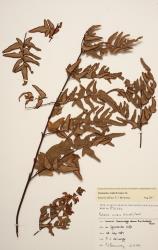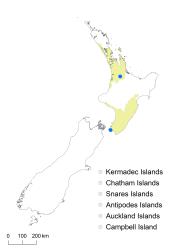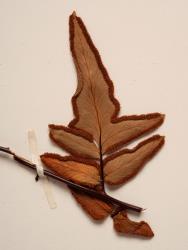- ≡ Pteris viridis Forssk., Fl. Aegypt.-Arab. cxxiv, 186 (1775)
- ≡ Adiantum viride (Forssk.) Vahl, Symb. Bot. (Vahl) 3, 104 (1794)
- ≡ Pteridella viridis (Forssk.) Kuhn in Decken, Reisen Ost. Afr., Bot. 3(3), 16 (1879)
- ≡ Pellaea viridis (Forssk.) Prantl, Bot. Jahrb. Syst. 3: 420 (1882)
- ≡ Hemionitis viridis (Forssk.) Christenh. in Christenhusz et al., Global Flora, GLOVAP Nomenclature 1, 4, 22 (2018)
In New Zealand, Cheilanthes viridis has glossy, dark red-brown stipes, rachises and costae. The fronds are up to 500 mm long and 250 mm wide; the laminae are 3-pinnate at the base, with tertiary pinnae 15–25 mm long and 6–12 mm wide, very similar in appearance to the primary pinnae of native Pellaea species, except that they are not articulated to the costae and rachis as they are in Pellaea. The veins are free. The sori extend along the margins of the ultimate segments but do not join at the apices.
North Island: Auckland, Southern North Island.
Altitudinal range: c. 50 m.
Collected from near Cambridge and in Wellington.
Occurs naturally in southern and eastern Africa, Yemen, Madagascar and India (Crouch et al. 2011). Naturalised in Queensland and New South Wales (Bostock 1998).
Cheilanthes viridis has been collected from ignimbrite cliffs above the Waikato River near Cambridge, probably as an escape from cultivation, and from a garden in Wellington, where it appeared spontaneously.
Webb et al. (1995), as Pellaea viridis. Voucher WELT P016336, 1987.
Forsskål’s Pteris viridis has been variously treated in Cheilanthes, Pellaea, Adiantum and Pteridella, but is now regarded as a species of Cheilanthes (Anthony 1984) because the pinnae and lamina segments are not articulated as they are in Pellaea.






